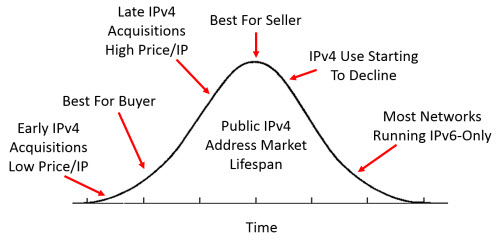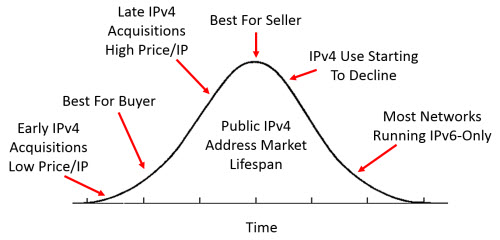IPv4 Address Exhaustion Has Occurred
It shouldn’t be a surprise to anyone that global IPv4 address exhaustion has occurred. The Internet community has been anticipating this for the past 20 years. The Internet Assigned Number Authority (IANA) free pool of IPv4 address space was depleted on February 3, 2011. The five Regional Internet Registries (RIRs) have been exhausting their stores of IPv4 addresses over the past four years. APNIC extinguished its supply of IPv4 addresses on April 15, 2011. RIPE NCC started their final stages of allocations from their remaining /8 on September 14, 2012. LACNIC announced the exhaustion of its IPv4 address pool on June 10, 2014. ARIN is now below 1/5th of their remaining /8 as part of their Phase 4 exhaustion policy. At the time this article was written, ARIN only had 14 percent of a /8 equivalent remaining. It is anticipated that ARIN will exhaust its supply of IPv4 addresses sometime in the summer of 2015.
Organizations that want to continue to grow their Internet-reachable systems will need to acquire addresses from service providers or find alternative sources of IPv4 addresses. Most organizations have no intention of disabling IPv4, so all companies must consider how they will sustain growth of their Internet-connected systems going forward.
You Need IPv4 Addresses for the Near Term and Long Haul
Your organization will continue to use IPv4 for the foreseeable future. It is highly probably that you intend to continue to use IPv4 for at least the next ten years. Organizations may have no choice but to acquire more IPv4 addresses as time goes on. Organizations should consider what happens when there are no more addresses to acquire from Regional Internet Registries (RIRs) or Internet Service Providers (ISPs).
One option is to move forward with your deployment of IPv6. This is an essential strategy for all organizations that want to preserve their ability to communicate with the broadest Internet population. However, in the short-term, what you do with IPv6 will have little impact on your dependence on IPv4. That is because your move toward enabling both IPv4 and IPv6 in parallel will not give you the ability to immediately disable IPv4. You will likely run both protocols for an extended period of time.
Buying More IPv4 Addresses
One possible option is for your organization to buy IPv4 addresses from organizations other than an RIR or an ISP. There are addressing policies that permit the address transfer process so long as organizations follow the rules of ICANN and the RIRs. For example, the American Registry for Internet Numbers (ARIN) Number Resource Policy Manual (NRPM) has the following sections that describe the process of transfers.
- Mergers and acquisitions – Section 8.2
- Transfers to specified recipients – Section 8.3
- Inter-RIR transfers – Section 8.4
Organizations are free to establish any compensation for their transfer independently. All that ARIN asks is that you work through their transfer process to keep the ownership information updated in their information. There is a transaction fee paid to ARIN for handling and updating of the information related to the transfer process.
There was a well-publicized address transfer that occurred in 2011 when Microsoft acquired addresses from the bankrupt Nortel Networks. People thought Microsoft was crazy, but they only paid $11 per IP address for a good sized block of addresses. Microsoft received 10 Class B equivalents (/16s) plus 44 Class C equivalents (/24s). Microsoft acquired a total of 666,624 IPv4 addresses from bankrupt Nortel Networks for ~$11.25 per address for a total price of $7.5 million. This large transfer established a benchmark in the pricing of public IPv4 addresses.
Another example was when Borders Books went out of business, but sold a /16 IPv4 address block (65,534 addresses) for ~$12.00 per address for a total price of $786,432. Based on this information, we can approximate the value of IPv4 addresses.
Even governments are getting into the act. We have seen recently that the UK government is selling off unused Internet addresses. The Department of Work and Pensions (DWP) in the UK has a largely unused /8 (16,777,216 IP addresses). The UK government recently sold 150,000 addresses to Altibox (a Norwegian firm) for about £600,000. When we convert pound sterling into U.S. dollars, this comes out to about $6.20 per IP address which is considered to be a good deal for the buyer.
Many organizations (like Jump.ro) from Romania have been selling IPv4 addresses in the RIPE region. Many of these Romanian IPv4 address blocks are going to organizations in the Middle East who are in need of addresses to continue their Internet growth.
An organization’s finance department may consider their public IPv4 addresses as an asset of the company and consider them in their financial analysis, market-valuation, and balance sheet. These public IPv4 addresses are almost like a “title” to real property with a defined value and treated like the trading of intellectual property.
Address Brokers
If your organization needs public IPv4 addresses, then you would need to find a company to buy from that has legitimate ownership of public IPv4 addresses. How would you go about finding addresses to buy? Would you use eBay or Craigslist? What you need is the Match.com of IPv4 addresses! Can you imagine what the profile descriptions might say?
- Eligible global manufacturing company seeking same for exchange of lucrative public IPv4 addresses and long-term courtship.
- Attractive financial company rebounding from a rocky financial breakup looking to sell voluptuous IPv4 assets.
Luckily, there are organizations that help facilitate this brokerage of IPv4 address transfers. ARIN refers to this as their Specified Transfer Listing Service (STLS). Address broker organizations that agree to follow ARIN’s policies on address transfers are allowed to be added to ARIN’s list of their registered STLS facilitators. Other registries have similar practices, but their policies may vary slightly. APNIC publishes a list of their registered IPv4 brokers on their web site. RIPE also publishes a list of their authorized address brokers.
From these lists you can find the companies that are among the largest address brokers and those that are affiliated and authorized to operate with many of the global RIRs. The following is a partial alphabetical list of these address broker companies:
- Addrex
- Avenue4 LLC
- Hilco Streambank
- IPTrading.com
- IPv4Auctions.com
- IPv4 Xchange, LLC
- IPv4 Market Group
- Jelly Digital LLC
- Kalorama Group, LLC
- Rent IPv4
- V4Escrow
- v4Now
Note: There are many other firms that provide these services, and more firms joining this market yearly. This was not intended to be an exhaustive list, but to list those that my research revealed most frequently.
Internet Routing Table Impact
The long-term problem with IPv4 address trading is that larger IPv4 address blocks will get broken up into much smaller blocks. Each of these smaller blocks may be advertised by their new owners to the Internet via BGP. This would increase the total number of IPv4 routes in the Internet’s “Default Free Zone.” This means that all routers on the Internet will require more memory to hold the entire BGP database.
Price Analysis for Buying or Selling
Based on these past transactions in the address transfer market we can estimate that the value of a single public IPv4 address today to be somewhere between $10 and $15 per IP address. We might expect to see volume discounts for larger transactions. Larger blocks are less expensive on a per-IP-address basis. In other words, larger blocks are more economical and the larger the block the lower the cost per-IP-address.
Also, just like in the real-world, timing is everything. The later an organization waits to sell their IPv4 addresses, the more money they get for them. The more scarce they are the more valuable they are, but as IPv6 gets more widely deployed (let’s say 60% penetration) then the value of the IPv4 addresses will fall.
Consider the following graph. As time goes on the value of public IPv4 addresses will increase up to a peak. As more organizations start to deploy IPv6, the value of IPv4 addresses will eventually start to fall.
As the price increases over time the following recommendations are natural conclusions:
- If you are going to sell addresses, then sell them as late as possible to get the highest price.
- If you know you need addresses, then buy them sooner rather than later. The price will only go up as scarcity increases.
Conclusions
Over time, IPv4 address may be treated like other scarce resources. Consider what happens when people perceive a shortage of Tickle-Me-Elmo dolls, bacon, peanut butter, Twinkies, rice, or Apple Watches. Imagine a world much like a “Mad Max” film where there are violent nomads roaming the vast wasteland in search of a single public IPv4 address. Over-dramatization aside, we can predict that IPv4 addresses will increase in desirability and, as a result, their value will go up.
The best strategy is for organizations to migrate to IPv6 early giving themselves the most options and the ability to sell their IPv4 assets at the peak prices. In other words, deploying IPv6 early will give your organization the luxury to sell of your valuable IPv4 addresses at peak market prices. Over time, more organizations will embrace IPv6 and its abundance of global addresses, making the eventual value of IPv4 address equivalent to cassette tapes.
This post originally appeared on the Infoblox blog at https://community.infoblox.com/blogs/2015/06/16/ipv4-address-trading-fun-and-profit.

